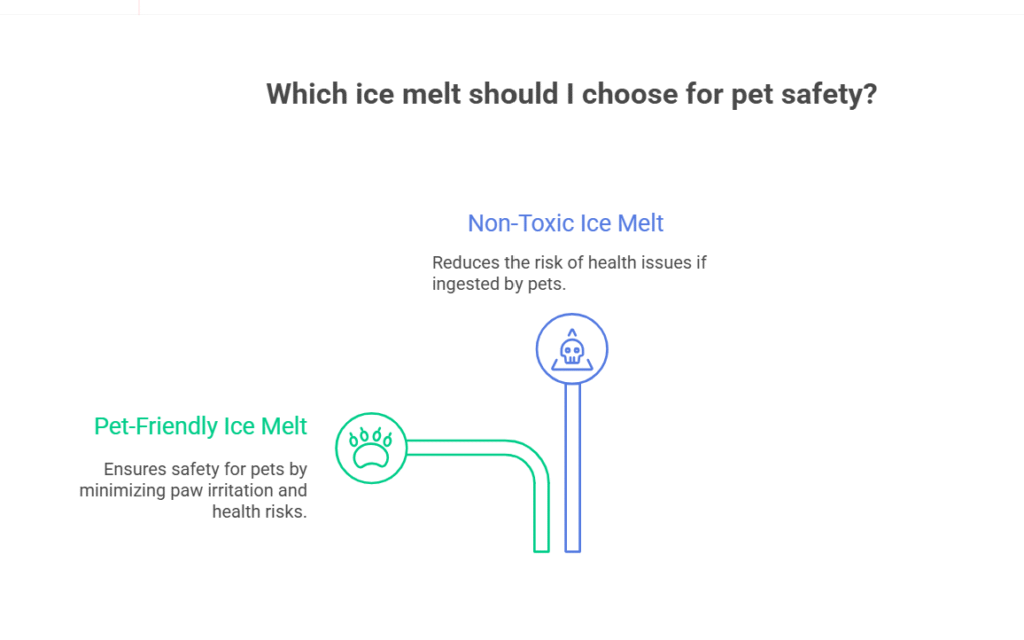Ice melt is a chemical product designed to lower the freezing point of water, making it easier to remove ice and snow from surfaces like driveways, sidewalks, and steps. Unlike traditional rock salt, modern ice melt products use a variety of compounds—each with its own pros and cons.
The Science Behind Ice Melt
When you sprinkle ice melt on frozen surfaces, it dissolves into a brine that penetrates the ice, breaking the bond between the ice and the ground. This process makes it easier to shovel or sweep away the remaining slush.
Common Types of Ice Melt
- Sodium Chloride (Rock Salt): The classic choice, effective down to about 15°F (-9°C).
- Calcium Chloride: Works in temperatures as low as -25°F (-32°C) and acts fast.
- Magnesium Chloride: Gentler on surfaces and plants, effective to -13°F (-25°C).
- Potassium Chloride: Less corrosive, but only works to about 20°F (-6°C).
- Blended Ice Melts: Combine several ingredients for balanced performance.
Choosing the Best Ice Melt for Your Needs
With so many options, how do you pick the right ice melt? Here’s what to consider:
Temperature Range
If you live in a region with extreme cold, look for products with calcium chloride or magnesium chloride. For milder climates, rock salt or potassium chloride may be enough.
Surface Compatibility
Some ice melts can damage concrete, brick, or stone. Always check the label for compatibility, especially if you’re treating new concrete or decorative surfaces.
Pet and Child Safety
Pet safe ice melt is a must for families with animals. Look for products labeled as “pet-friendly” or “non-toxic.” These are less likely to irritate paws or cause health issues if accidentally ingested.

Environmental Impact
Eco-friendly deicers are gaining popularity. These products use natural ingredients or biodegradable compounds to minimize harm to plants, soil, and waterways.
Real-Life Example: Ice Melt in Action
One homeowner shared, “Last winter, I switched to a pet safe ice melt after my dog’s paws got irritated. Not only did it work just as well as regular salt, but I felt better knowing my yard and garden were safer too.”
Ice Melt vs. Salt: What’s the Difference?
While “ice melt” and “salt” are often used interchangeably, they’re not the same. Rock salt is just one type of ice melt, and it’s not always the best choice.
Pros and Cons of Rock Salt
- Pros: Affordable, widely available, effective in moderate cold.
- Cons: Can damage concrete, harm plants, and irritate pets.
Pros and Cons of Modern Ice Melts
- Pros: Work at lower temperatures, less corrosive, safer for pets and plants.
- Cons: Can be more expensive, some blends may leave residue.
How to Apply Ice Melt for Maximum Effectiveness
Applying ice melt isn’t just about dumping a bag on your driveway. Here’s how to get the best results:
Clear Snow First
Remove as much snow as possible before applying ice melt. This reduces the amount you need and helps the product work faster.
Use the Right Amount
More isn’t always better. Overusing ice melt can damage surfaces and harm the environment. Follow the manufacturer’s instructions for proper coverage.
Spread Evenly
Use a handheld or walk-behind spreader for large areas. For steps and small spots, a scoop or cup works well.
Reapply as Needed
After shoveling or plowing, you may need to reapply ice melt to prevent refreezing.
Ice Melt Safety: Protecting People, Pets, and Property
Pet Safety
Always choose pet safe ice melt if you have animals. Wipe your pet’s paws after walks to remove any residue, and store ice melt products out of reach.
Surface Protection
Avoid using ice melt on new concrete (less than a year old), as it’s more susceptible to damage. Rinse surfaces in spring to remove any leftover chemicals.
Environmental Tips
Sweep up excess ice melt after the ice is gone. This prevents runoff into storm drains and reduces harm to plants and waterways.
Eco-Friendly Ice Melt: What’s New in 2025?
Sustainability is a top concern for many homeowners and businesses. In 2025, eco-friendly ice melt options are more effective and accessible than ever.
Natural Ingredients
Some products use beet juice, corn-based compounds, or sand to provide traction and melting power without harsh chemicals.
Biodegradable Blends
Look for ice melts labeled as biodegradable or “green.” These break down naturally and are less likely to harm the environment.
Local Regulations
Some cities now restrict the use of certain ice melt chemicals. Check your local guidelines before purchasing.
Storing and Handling Ice Melt
Proper storage extends the life of your ice melt and keeps it safe from kids and pets.
- Keep in a sealed container to prevent clumping and moisture absorption.
- Store in a cool, dry place away from direct sunlight.
- Label containers clearly and keep out of reach of children and animals.
Ice Melt for Different Surfaces
Driveways and Walkways
Most ice melts are safe for asphalt and older concrete. For decorative or stamped concrete, choose a product labeled as “surface safe.”
Steps and Entryways
Use pet safe or eco-friendly ice melt near doors and high-traffic areas. These are less likely to be tracked indoors or cause slips.
Roofs and Gutters
Specialized ice melt products are available for roofs and gutters. Never use regular rock salt, as it can damage shingles and metal.
Ice Melt and Winter Maintenance for Businesses
For property managers and business owners, ice melt is a critical part of winter safety.
Liability and Safety
Slips and falls are a major liability. Regularly applying ice melt to parking lots, sidewalks, and entryways helps prevent accidents and keeps customers safe.
Bulk Purchasing
Buying ice melt in bulk can save money and ensure you’re prepared for winter storms. Many suppliers offer delivery and storage solutions for large properties.
Innovations in Ice Melt: What’s Next?
Smart Spreaders
In 2025, smart spreaders with app connectivity and weather integration are making it easier to apply the right amount of ice melt at the right time.
Fast-Acting Formulas
New blends are designed to work faster and last longer, reducing the need for frequent reapplication.
Color-Enhanced Products
Some ice melts now include color additives, making it easy to see where you’ve already applied product—no more missed spots!
Common Mistakes to Avoid with Ice Melt
- Overapplying: Wastes product and increases risk of damage.
- Using the wrong type: Not all ice melts are safe for every surface.
- Ignoring pet safety: Always check for pet safe labels if you have animals.
- Storing improperly: Moisture can ruin ice melt and make it less effective.
Real-World User Quote
“I used to think all ice melts were the same, but after switching to an eco-friendly blend, I noticed my plants survived winter much better. It’s worth spending a little more for peace of mind.”
FAQs
Q. What is the best ice melt for concrete driveways?
A. Look for calcium magnesium acetate or magnesium chloride blends. These are less likely to damage concrete compared to traditional rock salt.
Q. Is ice melt safe for pets?
A. Not all ice melts are pet safe. Choose products labeled as “pet-friendly” and always wipe your pet’s paws after exposure.
Q. How does ice melt work in extremely cold temperatures?
A. Calcium chloride and magnesium chloride are effective at much lower temperatures than rock salt. For subzero conditions, these are your best bet.
Q. Can I use ice melt on new concrete?
A. It’s best to avoid using any ice melt on concrete less than a year old, as it’s more vulnerable to damage. Use sand for traction instead.
Final Thoughts
Choosing the right ice melt in 2025 means balancing effectiveness, safety, and environmental impact. With new products and smarter application methods, it’s easier than ever to keep your property safe without harming pets, plants, or the planet.
CLICK HERE FOR MORE BLOG POSTS
There’s a certain weight in the words John Authers writes—not just because of what he knows, but how he shares it. His voice doesn’t just echo facts; it builds meaning. In a world overwhelmed by rushed opinions and robotic summaries, John’s writing feels… different. It feels lived-in, thoughtful, and deeply human.
Readers don’t turn to John for headlines—they come for context. They come for that rare blend of clarity, insight, and emotional depth that turns financial journalism into something closer to storytelling. His reflections on markets, geopolitics, or human behavior aren’t just readable—they’re relatable.
What sets John apart isn’t just his experience (though he has plenty of it). It’s his ability to pause, reflect, and explain the why behind the what. He writes like someone who’s been in the room where it happens—but never forgets the reader who hasn’t.
In 2025, when AI churns out articles in milliseconds, John Authers still writes like a human—and that, more than anything, is what makes his work worth reading.











